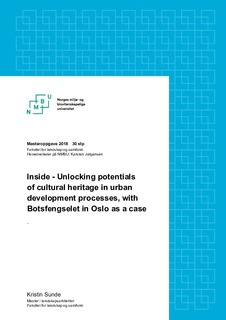| dc.contributor.advisor | Jørgensen, Karsten | |
| dc.contributor.author | Sunde, Kristin Klyve | |
| dc.coverage.spatial | Norway, Oslo | nb_NO |
| dc.date.accessioned | 2018-11-08T12:19:18Z | |
| dc.date.available | 2018-11-08T12:19:18Z | |
| dc.date.issued | 2018 | |
| dc.identifier.uri | http://hdl.handle.net/11250/2571625 | |
| dc.description.abstract | This research is a contribution to the contemporary discussion concerning preservation and development in urban environments, and more specifically to the discussion as to how one can bridge or translate international and national policy ambitions into actual practices and strategies. There exists noble political ambitions to democratize cultural heritage management, and to strenghten the value of cultural heritage within the green shift. A central part of this thesis therefore comprises of exploring the role of cultural heritage within the green shift, and to investigate connections between history, place, and people. This exploratory research reveals potentials in cultural heritage as a resource within the green shift, and as a force in civic life. The research also reveals potentials in inclusive, process-oriented strategies for securing a more sustainable praxis for managing heritage.
Through the case of Botsfengselet in Oslo, this thesis contributes to highlight critical issues concerning present-day heritage management processes. These issues restrain cultural heritage as a potential force in securing sustainable, resilient urban developments, and should therefore be challenged. Lastly, this research will demonstrate ways in which to activate the historical landscape of Botsfengselet that bridges the site with the broader landscape while strenghtening the historical narratives on site. Connecting past, present and future together in new ways represents radical but grounded urban development, and can generate unique experiences of landscape, and create the cultural heritage of the future. | nb_NO |
| dc.description.abstract | Denne oppgaven er et bidrag til den dagsaktuelle diskusjonen rundt bevaring og utvikling i bymiljøer, nærmere bestemt diskusjonen om hvordan man kan knytte internasjonale og nasjonale politiske ambisjoner til faktiske prosesser og strategier. Det finnes sterke politiske ambisjoner om å demokratisere forvaltning av kulturminner, og å styrke verdien av kulturarven innenfor det grønne skiftet. En viktig del av denne oppgaven innebærer derfor å utforske kulturarvens rolle innenfor det grønne skiftet, og undersøke sammenhenger mellom historie, sted og folk. Denne undersøkende forskningen viser at det finnes et betydelig potensiale i kulturarv som en ressurs innenfor det grønne skiftet, og som en motor i byutviklingen. Denne oppgaven viser også til et behov for inkluderende, prosessorienterte strategier for å sikre en mer bærekraftig praksis for forvaltning av kulturarv.
Gjennom Botsfengselet i Oslo som et case, bidrar denne oppgaven til å fremheve kritiske problemstillinger knyttet til dagens kulturminneforvaltning. Disse problemene reduserer kraften i kulturminner som bidrag i kampen for mer bæredyktige og resiliente bymiljøer. Til slutt vil denne oppgaven demonstrere hvordan man kan aktivisere Botsfengselets historiske landskap på en måte som bygger bro mellom fengselsområdet og det større landskapet. Oppgaven viser også hvordan aktivisering av det historiske landskapet kan forsterke historiske verdier og fortellinger på stedet. Å knytte fortid, nåtid og fremtid sammen på nye måter representerer radikal, men fornuftig byutvikling og kan generere unike, felles opplevelser som kan bli fremtidens kulturminner | nb_NO |
| dc.description.sponsorship | Alternative Byrom: Unges Framtidshistorier (AFI) | nb_NO |
| dc.language.iso | eng | nb_NO |
| dc.publisher | Norwegian University of Life Sciences, Ås | nb_NO |
| dc.rights | Attribution-NonCommercial-NoDerivatives 4.0 Internasjonal | * |
| dc.rights.uri | http://creativecommons.org/licenses/by-nc-nd/4.0/deed.no | * |
| dc.subject | Landscape democracy | nb_NO |
| dc.subject | Preservation | nb_NO |
| dc.subject | Landscape narratives | nb_NO |
| dc.subject | Sites of consciousness | nb_NO |
| dc.title | Inside : unlocking potentials of cultural heritage in urban development processe : with Botsfengselet in Oslo as a case | nb_NO |
| dc.type | Master thesis | nb_NO |
| dc.description.version | acceptedVersion | nb_NO |
| dc.subject.nsi | VDP::Humaniora: 000 | nb_NO |
| dc.source.pagenumber | 197 | nb_NO |
| dc.description.localcode | M-LA | nb_NO |

